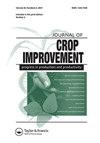乌干达茶(Camellia sinensis)种质的理化分析揭示了潜在的商业绿茶和红茶品种
IF 1.5
Q3 AGRONOMY
引用次数: 1
摘要
茶(Camellia sinensis L.)是世界范围内消费的重要饮料。在乌干达,它是仅次于咖啡的第二大、高度优先的出口作物,为80多万人提供了急需的就业机会。尽管该作物在该国很重要,但由于其改良和最佳利用,该作物受到的研究关注非常有限。这项研究旨在表征乌干达现有的茶叶种质,为未来市场首选茶叶品种的育种计划提供信息。从位于Rwebitaba的乌干达茶叶研究中心保存的茶叶种质中随机选择58个高级茶无性系,并在实验室中分析8个理化描述符。使用cluster-R软件包对58个无性系进行了层次聚类分析,发现了四个主要聚类,表明试验种质中理化参数存在变异。这种变异可以用来在所研究的种质中进行选择和/或从遗传上提高质量。高发酵率是优质红茶的关键指标之一,它揭示了15个快速发酵茶无性系。克隆“UTR12/12”被鉴定为最快速的发酵罐,在30分钟内完全发酵,这意味着一个很好的红茶克隆。该克隆的多酚含量最高(26.7%),高于优质克隆“UTR6/8”(对照)。多酚含量在对照红茶无性系范围内的其他茶无性系有:“UTR144/10”(20.9%)和“UTR144-17”(20.66%)。已确定的有前景的红茶无性系可以进行多地点试验,以进一步评估和选择最终作为商业红茶无性系发布的品种。本文章由计算机程序翻译,如有差异,请以英文原文为准。
Physicochemical analysis of Ugandan tea (Camellia sinensis) germplasm reveals potential commercial green and black tea varieties
ABSTRACT Tea (Camellia sinensis L.) is an important beverage consumed worldwide. In Uganda, it is the second-largest and highly prioritized export crop after coffee and provides the much-needed jobs to more than 800,000 people. Despite its importance in the country, the crop has received very limited research attention for its improvement and optimal utilization. This study was aimed at characterizing existing tea germplasm in Uganda to inform future breeding initiatives for market-preferred tea varieties. Fifty-eight advanced tea clones were randomly selected from the tea germplasm conserved at Uganda’s Tea Research Center in Rwebitaba and analyzed in the laboratory for eight physicochemical descriptors. Hierarchical cluster analysis performed on the 58 clones using Cluster-R package revealed four main clusters, indicating the existence of variation for physicochemical parameters within tested germplasm. This variation can be exploited to select among and/or improve the studied germplasm genetically for quality. High fermentation rate, which is one of the key indicators for good-quality black teas, revealed 15 fast-fermenter tea clones. Clone “UTR12/12” was identified as the most rapid fermenter, fully fermenting within 30 min, which implies a good clone for black tea. The clone also had the highest polyphenol content (26.7%), higher than the high-quality clone “UTR6/8” (control). Other tea clones whose polyphenol content was within the range of the control black tea clone were: “UTR144/10” (20.9%) and ‘UTR144/17, (20.66%). The identified promising black tea clones can be advanced to multi-location trials for further evaluation and selection for eventual variety release as commercial black-tea clones.
求助全文
通过发布文献求助,成功后即可免费获取论文全文。
去求助
来源期刊

Journal of Crop Improvement
Multiple-
CiteScore
3.30
自引率
7.70%
发文量
42
期刊介绍:
Journal of Crop Science and Biotechnology (JCSB) is a peer-reviewed international journal published four times a year. JCSB publishes novel and advanced original research articles on topics related to the production science of field crops and resource plants, including cropping systems, sustainable agriculture, environmental change, post-harvest management, biodiversity, crop improvement, and recent advances in physiology and molecular biology. Also covered are related subjects in a wide range of sciences such as the ecological and physiological aspects of crop production and genetic, breeding, and biotechnological approaches for crop improvement.
 求助内容:
求助内容: 应助结果提醒方式:
应助结果提醒方式:


